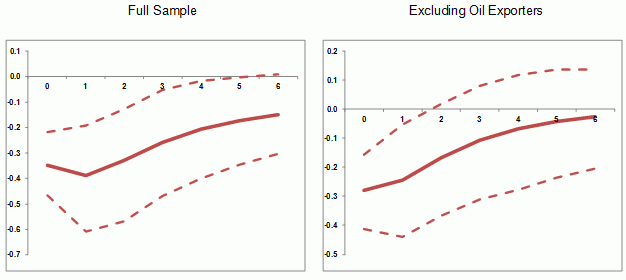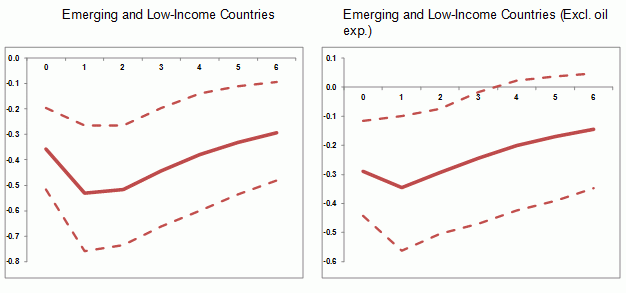Today, as in the 1980s, government deficits and trade deficits are growing in tandem in some nations while government surpluses and trade surpluses are growing in others. This has put the relationship between fiscal policy and the current account back on centre stage – especially as many observers believe that the post-crisis world will be heavily influenced by the path of trade and fiscal imbalances (see for example Claessens et al. 2010, Nguyen and Servén 2010, and Reinhart and Rogoff 2010).
The relationship between fiscal policy and the current account has long attracted interest among academic economists and policymakers. Many of us remember influential debates on the “twin deficit” hypothesis that began in the 1980s (Chinn 2005, Bartolini and Lahiri 2006). More recently, large global imbalances, and the low cost of financing they entailed, have been viewed by many as a contributing factor to the crisis (Suominen 2010). Going forward, the implications of the recent fiscal stimulus and projected fiscal retrenchment over the medium term for current-account developments and global imbalances will continue to generate interest in the context of returning the world economy to strong and balanced growth as the effects of the global crisis gradually abate.
Hypotheses from the literature
The traditional starting point for studying the fiscal policy-current account nexus has been the savings-investment identity, i.e., the current account as a sum of the private sector’s savings-investment balance and the fiscal balance, i.e. X-M = S–I + G-T using the familiar textbook notation (Mankiw 2009). The standard expectation is that an increase in the government’s consumption or investment demand for tradable goods, or a fiscal expansion more generally, should be reflected in a larger current-account deficit. The strength (or even direction) of this impact depends on several factors:
- Whether agents are myopic or Ricardian;
- the role of relative prices (real exchange rate/terms of trade);
- the extent of excess capacity in the economy (i.e. the size of the output gap/elasticities);
- the degree of economic and financial openness; and
- the response of interest rates and country risk premia.
The importance of country characteristics suggests that any empirical analysis in this area would benefit from analysing groups of countries with shared features (e.g., similar levels of economic development; susceptibility to terms of trade shocks etc.).
While previous studies of the fiscal policy-current account relationship have focused on advanced economies and, especially, the US, our recent paper analyses the association between fiscal policy and the current account drawing on a sample of more than 100 countries, covering more than two decades (Abbas et al. 2010). We distinguish among advanced, emerging, and low-income countries; more and less open economies; and country-years with small and large output gaps. We emphasise the results for non-oil exporters, as the strong association between the fiscal balance and the current account for oil-exporters is clearly driven by the simultaneous impact of oil price changes on both fiscal revenues and exports. We use a range of estimation methods and the broad findings hold across different empirical approaches.
We find that changes in fiscal policy are indeed associated with changes in the current account, but the relationship is far less than one-for-one.
What we learn from the data: Large and small episodes
We start with a static analysis of the national account identity and we look at events where we have witnessed large changes in the current account or the fiscal balance. The analysis of these large episodes suggests that, for the most part, the emergence or unwinding of large current-account imbalances is not closely associated with fiscal policy changes. We also find that large fiscal expansions or contractions have rarely displayed a one-for-one association with current-account changes. For these large episodes, only a mild association is observed, primarily for low-income countries.
Yet when we look at all possible changes in the fiscal balances (using panel regressions), a strengthening in the fiscal balance by 1 percentage point of GDP is associated with a current-account improvement of 0.3 percentage point of GDP. When we analyse different groups of countries we find smaller effects for non-oil exporters (around 0.28) as well as advanced economies (0.24), while the effects are larger for emerging and developing economies (0.31). A possible interpretation is that, in emerging and developing economies, public spending tends to include more heavily the purchase of foreign-manufactured investment goods.
A key additional finding is that the level of the output gap significantly affects the association between fiscal policy and the current account. Focusing on a sub-sample of advanced and some emerging economies where meaningful measures of the output gap are available, we find that the estimated coefficient (0.46) is significantly higher in country-years where output is above potential than it is (0.26) in country-years where output is below potential. A possible interpretation of this result is that when output is above its potential, a fiscal expansion is more likely to result in additional imports. When output is instead below potential, the additional demand stemming from a fiscal expansion is more likely to be met by increased production of domestic goods and services, rather than through imports.
Some dynamic results
To analyse the dynamic impact of fiscal policy changes on the current account, we run a panel VAR specification. Fiscal policy changes are proxied by changes in real government consumption. The key variable of interest remains the current account-to-GDP ratio. The specification is similar to Monacelli and Perotti (2007), except that we run panel VARs, removing individual country fixed effects.
A fiscal expansion (i.e. an increase in government consumption) generally leads to a worsening in the current-account balance (about 0.2-0.3), though the duration of the impact depends on the country sample.
Figure 1. Current-account response to changes in the log of real government consumption
Figure 1 (top left-hand side panel) shows the evolution of the current-account-to-GDP ratio following an increase in real government consumption (the size of the increase is equivalent to an increase in the government spending-to-GDP ratio by 1.35 percentage points). The dashed lines represent a 90 percent confidence interval for the responses, estimated using Monte Carlo simulations with 500 iterations.
The effect upon impact is significant. During the year of the spending shock, the current account deteriorates by 0.35 percentage points of GDP. With oil exporters excluded (top right-hand side panel), the implied coefficient is smaller, as expected, at 0.28 percentage points of GDP. Equivalently, a government consumption increase by 1 percentage point of GDP would worsen the current account balance by 0.26 percentage points of GDP during the year of the shock in the full sample, and 0.20 percentage points of GDP in the sample without oil exporters. For the full sample, the impact is somewhat smaller but still (marginally) significant after six years; excluding the oil exporters, the impact is no longer significantly different from zero after a couple of years and is estimated to be very small after five or six years.
When we split countries by their level of development we find that in response to an increase in government consumption, the current account worsens by 0.20 percentage points of GDP during the year of the shock (and by 0.24 percentage points of GDP one year after the shock). The impact gradually peters out and becomes insignificant after four years for the sample that excludes oil exporters.
Conclusion
Overall, we find that a strengthening in the fiscal balance by 1 percentage point of GDP is, on average, associated with a current account improvement of 0.2–0.3 percentage points of GDP. This association is as strong in emerging and low-income countries as it is in advanced economies; and significantly higher when output is above potential.
The views expressed herein are those of the authors and should not be attributed to the IMF, its Executive Board, or its management.
References
Abbas, SM Ali, Jacques Bouhga-Hagbe, Antonio Fatás, Paolo Mauro, and Ricardo C. Velloso (2010), “Fiscal Policy and the Current Account”, CEPR Discussion Paper 7859.
Bartolini, Leonardo and Armatya Lahiri (2006), “Twin Deficits, Twenty Years Later”, Federal Reserve Bank of New York, 12(7).
Chinn, Menzie D (2005), “Getting Serious About the Twin Deficits”, Council Special Report No 10, Council on Foreign Relations.
Claessens, Stijn, Simon J Evenett, and Bernard Hoekman (eds.) (2010), Rebalancing the Global economy: A Primer for Policymaking, A VoxEU.org Publication, 23 June.
Nguyen, Ha and Luis Servén (2010), “Global imbalances: Origins and prospects”, VoxEU.org, 29 July.
Mankiw, Gregory N (2009), Macroeconomics/ Edition 7, Worth Publishers.
Monacelli, Tommaso, and Roberto Perotti (2007), “Fiscal Policy, the Trade Balance, and the Real Exchange Rate: Implications for International Risk Sharing”, Università Bocconi, Milan, Italy.
Reinhart, Carmen M and Kenneth Rogoff (2010), “Debt and growth revisited”, VoxEU.org, 11 August.
Suominen, Kati (2010), “Did Global Imbalances Cause the Crisis”, VoxEU.org, 14 June.










